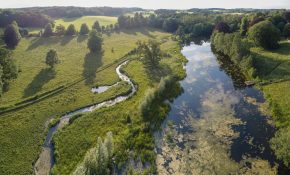Warham: Returning the River Stiffkey Back to its Natural Course
Warham: Returning the River Stiffkey Back to its Natural Course
Returning the Stiffkey to its original course between Warham and Wighton is a significant win for the river and local wildlife.
The Challenge
From source to sea, the river Stiffkey is approximately 29 km long. Starting from North Norfolk springs, where it traverses diverse landscapes characterised by sand, gravel, clay, and, notably, chalk, it converges with the sea at Blakeney Harbour. It is the presence of this chalk bedrock that gives the river its clear waters and unique wildlife.
However, 300–400 years ago, human intervention confined sections of the Stiffkey to a straight channel, as the power of water was harnessed for working mills. This disrupted the connection between the river and its surrounding habitat, impeding its natural overflow onto the floodplain.
The Impact
In collaboration with the Holkham Estate and Charles Rangeley-Wilson, a 2km section of the river Stiffkey between Warham and Wighton was reunited with its floodplain through the creation of a new meandering channel, which closely follows its historic course. This transformative project will enhance biodiversity, mitigate sediment build-up and implement natural flood management by slowing the flow of water.
As part of the restoration effort, logs and woody debris were strategically placed within the new river channel to constrict flow, thus creating diverse habitat niches conducive to supporting fish populations and a variety of invertebrate species.
Ed Bramham Jones, CEO of Norfolk Rivers Trust, said:
“Chalk streams are incredibly rare… We want them to be dynamic so that in high flows they spill over their banks and onto the floodplain, thereby creating a fantastic habitat for plant life and other species.”
In just a short period since the completion of the restoration work, an impressive array of wildlife has been spotted visiting the site. This includes little egrets, great white egrets, curlews, woodcocks, otters and kingfishers, along with water vole tracks.
Funding
With thanks to funding support from the Green Recovery Challenge Fund, Anglian Water and the Esmée Fairbairn Foundation.

Drone image of the newly created channel, a channel which follows its historic course.

A 2km section of the river Stiffkey between Warham and Wighton was reunited with its floodplain.











